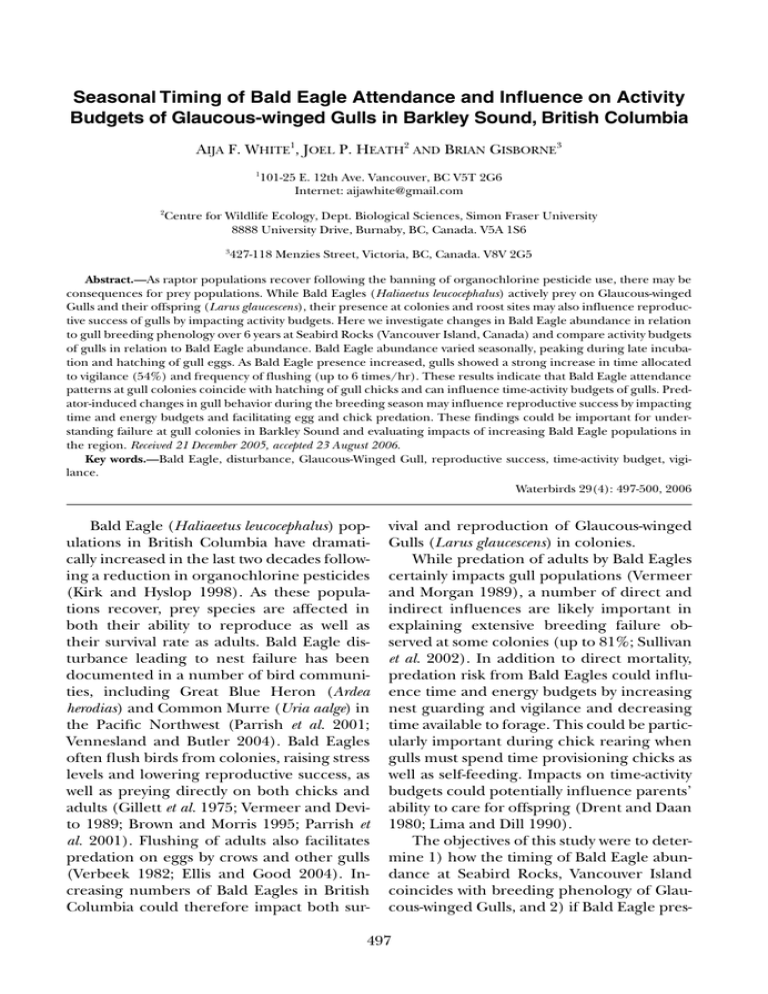Seasonal Timing of Bald Eagle Attendance and Influence on Activity
advertisement

Seasonal Timing of Bald Eagle Attendance and Influence on Activity Budgets of Glaucous-winged Gulls in Barkley Sound, British Columbia AIJA F. WHITE1, JOEL P. HEATH2 AND BRIAN GISBORNE3 1 2 101-25 E. 12th Ave. Vancouver, BC V5T 2G6 Internet: aijawhite@gmail.com Centre for Wildlife Ecology, Dept. Biological Sciences, Simon Fraser University 8888 University Drive, Burnaby, BC, Canada. V5A 1S6 3 427-118 Menzies Street, Victoria, BC, Canada. V8V 2G5 Abstract.—As raptor populations recover following the banning of organochlorine pesticide use, there may be consequences for prey populations. While Bald Eagles (Haliaeetus leucocephalus) actively prey on Glaucous-winged Gulls and their offspring (Larus glaucescens), their presence at colonies and roost sites may also influence reproductive success of gulls by impacting activity budgets. Here we investigate changes in Bald Eagle abundance in relation to gull breeding phenology over 6 years at Seabird Rocks (Vancouver Island, Canada) and compare activity budgets of gulls in relation to Bald Eagle abundance. Bald Eagle abundance varied seasonally, peaking during late incubation and hatching of gull eggs. As Bald Eagle presence increased, gulls showed a strong increase in time allocated to vigilance (54%) and frequency of flushing (up to 6 times/hr). These results indicate that Bald Eagle attendance patterns at gull colonies coincide with hatching of gull chicks and can influence time-activity budgets of gulls. Predator-induced changes in gull behavior during the breeding season may influence reproductive success by impacting time and energy budgets and facilitating egg and chick predation. These findings could be important for understanding failure at gull colonies in Barkley Sound and evaluating impacts of increasing Bald Eagle populations in the region. Received 21 December 2005, accepted 23 August 2006. Key words.—Bald Eagle, disturbance, Glaucous-Winged Gull, reproductive success, time-activity budget, vigilance. Waterbirds 29(4): 497-500, 2006 Bald Eagle (Haliaeetus leucocephalus) populations in British Columbia have dramatically increased in the last two decades following a reduction in organochlorine pesticides (Kirk and Hyslop 1998). As these populations recover, prey species are affected in both their ability to reproduce as well as their survival rate as adults. Bald Eagle disturbance leading to nest failure has been documented in a number of bird communities, including Great Blue Heron (Ardea herodias) and Common Murre (Uria aalge) in the Pacific Northwest (Parrish et al. 2001; Vennesland and Butler 2004). Bald Eagles often flush birds from colonies, raising stress levels and lowering reproductive success, as well as preying directly on both chicks and adults (Gillett et al. 1975; Vermeer and Devito 1989; Brown and Morris 1995; Parrish et al. 2001). Flushing of adults also facilitates predation on eggs by crows and other gulls (Verbeek 1982; Ellis and Good 2004). Increasing numbers of Bald Eagles in British Columbia could therefore impact both sur- vival and reproduction of Glaucous-winged Gulls (Larus glaucescens) in colonies. While predation of adults by Bald Eagles certainly impacts gull populations (Vermeer and Morgan 1989), a number of direct and indirect influences are likely important in explaining extensive breeding failure observed at some colonies (up to 81%; Sullivan et al. 2002). In addition to direct mortality, predation risk from Bald Eagles could influence time and energy budgets by increasing nest guarding and vigilance and decreasing time available to forage. This could be particularly important during chick rearing when gulls must spend time provisioning chicks as well as self-feeding. Impacts on time-activity budgets could potentially influence parents’ ability to care for offspring (Drent and Daan 1980; Lima and Dill 1990). The objectives of this study were to determine 1) how the timing of Bald Eagle abundance at Seabird Rocks, Vancouver Island coincides with breeding phenology of Glaucous-winged Gulls, and 2) if Bald Eagle pres- 497 498 WATERBIRDS ence on and near the colony influences time-activity budgets of gulls by increasing time spent vigilant and frequency of flushing from roosting and nesting sites. We discuss the relevance of our findings for understanding both direct and indirect influences of increasing eagle populations on recent gull colony failures (Sullivan et al. 2002). METHODS Eagle Abundance Surveys The abundance of Bald Eagles present at Seabird Rocks (43°43’N, 125°09’W) was counted several times weekly from a boat by an experienced observer from May until late September from 1999-2004. The sampling was opportunistic, dependent upon weather and other considerations; however, there were on average 4 counts per week (±0.8 SD) consistently from May to August in the years used in the analysis. The total number of trips made in any month did not vary by more than five, so the opportunities for Bald Eagle observation were approximately equal. Time-activity Budgets We observed gull colonies at Seabird Rocks (49°43’N, 125°09’W) and Wizard Island (48°50’N, 125°08’W) in Barkley Sound, BC during June and July of 2005. Seabird Rocks was observed from a boat approximately 100-300 m offshore using 8 × 24 binoculars. At Seabird Rocks, observations were conducted from 11.00 to 13.00 h on 17 and 24 June, and 1 and 8 July, 2005. At Wizard Island, observations were conducted using a 60× spotting scope from Helby Island, (approximately 500 m away) for a total of 32 hours distributed between 06.00 and 19.30h between 22, 27, 28 June, and 2, 4 and 8 July, 2005. At both sites, data was collected using scan sampling every 15 minutes to measure the abundance of gulls, and number involved in preening, vigilance or other behaviors. Additionally, focal sampling of individuals was conducted for 5 minute intervals on randomly selected birds using the same behavioral categories (preening/vigilant/other). The number of Bald Eagles present on the colony and in proximity to the colony was counted at the beginning of the scan or focal sample, as well as when the gulls on the colony flushed. At Seabird Rocks, a general estimation of 500 m was judged to be in proximity. Wizard Island was surrounded, for the most part, on all sides by other islands between 200 and 500 m. Inside this area, and thus, easily visible to the gulls on the colony, was considered in proximity. The frequency of Bald Eagle-induced disturbances was defined as the number of approaches which caused the gulls to flush and was recorded by counting the number of disturbances during each observation period. Statistical Analysis When data passed Levene’s test for equality of variance and the Shapiro-Wilks test for normality, analysis of variance compared activity budgets of gulls as a function of predation risk from Bald Eagles (defined cate- gorically as number of eagles present ranged from 0 to 4). Data not meeting normality assumptions were analyzed using Kruskall-Wallis and median nonparametric tests. Averages plus and minus standard deviations are presented in the text. RESULTS Bald Eagle abundance at the Seabird Rocks colony peaked in the last two weeks of June, with an average (±SD) number of 4.3 ± 1.62 eagles sighted per visit. Bald Eagles were significantly less abundant in early May and late August, which had mean sightings of 1.2 and 0 eagles per visit, respectively (±0.7, ±1.20; Fig. 1; Kruskall-Wallis test, χ23 = 18.00, P ≤ 0.01). There was no significant amongyear differences in the trend of increasing Bald Eagle abundance until 15-30 June, and declining abundance thereafter (χ25 = 1.00, P > 0.05). Therefore, the abundances for all years were pooled for comparison with gull breeding phenology (Reid 1987; Campbell et al. 1997). On an hourly basis, the flock size of gulls at both colonies did not vary with number of Bald Eagles present on the colony, with 45 gulls being the average size of flocks sampled at both locations (ANOVA, F3,71 = 0.23, P > 0.05). The number of vigilant individuals in the flock increased significantly in relation to number of Bald Eagles in proximity to the colony (Table 1; χ23 = 7.45, P < 0.05; similar Figure 1. Mean abundance of eagles sighted per visit by an observer (± SE) at Seabird Rocks between 1999-2004 during May, June, July, and August, divided into biweekly segments. A Kruskall-Wallis test indicates a significant effect of month. The peak in eagle abundance closely corresponds with early hatching period for gulls (June 20-July 10). EAGLE-GULL INTERACTIONS results were observed for Bald Eagles directly on the colony; χ21 = 9.03, P ≤ 0.01). Additionally, the frequency of Bald Eagle disturbance (flushes) increased with eagle presence in the immediate area near the colony, with significant increases in flush frequency when Bald Eagle presence increased from 1 to 4 (Table 1; χ24 = 12.78, P ≤ 0.01). Focal sampling also indicated that the amount of time spent vigilant in a 5-minute interval increased in relation to number of Bald Eagles present on the colony (Table 1; χ22 = 13.93, P ≤ 0.01). The ratio of total time spent preening to time spent being vigilant decreased significantly as Bald Eagle presence increased, to a minimum of 0.45 when two Bald Eagles were present, in comparison with 7.9 when no Bald Eagles were present (Table 1; χ22 = 7.22, P < 0.05). A survey of Seabird rocks on July 6, 2005 indicated that 89% of observed gull nests were empty, while only 6% and 5% had one and 2 eggs, respectively. While an unseasonal storm in late May could have impacted some nests, predated egg shells were observed in proximity to many empty nests around the colony. DISCUSSION Across all six years, Bald Eagles increased in abundance at Seabird Rocks throughout the gull breeding season, peaking in late June, which coincided with late incubation and early gull hatching (20 June-10 July; Reid 1987; Campbell et al. 1997). This timing may allow Bald Eagles to exploit developing 499 embryos or fed gull chicks, which could provide greater energy gain than foraging on undeveloped eggs which are perhaps easily broken or wasted. During incubation and brood rearing (late May-early August) Bald Eagles were present during 99% of surveys. This persistent abundance of Bald Eagles therefore occurred during the most energetically demanding phase of gull breeding cycles (Verbeek 1986; Reid 1987). While Bald Eagles can directly impact Glaucous-winged Gull populations through predation on adults and chicks (Verbeek 1986; Vermeer and Morgan 1989; Sullivan et al. 2002), indirect effects may also be important. Increased flushing and vigilance in the presence of Bald Eagles and lower preen-tovigilance ratios indicate Bald Eagles also influence time-activity budgets of gulls at the colony. These changes in gull activity budgets were observed at both flock and individual levels. Increased vigilance necessitates a reduction in time available for other activities such as foraging. This effect may be particularly important as our results indicate Bald Eagle abundance peaks when gull time and energy demands are high during provisioning and brood rearing (Beauchamp 2005). Bald Eagles prey on adult gulls, eggs and chicks (Verbeek 1986; Vermeer and Morgan 1989; Parrish et al. 2001) and so increased flushing of adults could indicate parents are trading off survival at a cost of increased predation risk on eggs and chicks (Lima and Dill 1990). Such a trade-off is often common in long lived seabird species during poor years (Wanless et al. 2005). How- Table 1. Changes in flock and individual behavior with increasing Bald Eagle presence near the colony site during scan and focal sampling. The number of vigilant individuals in the flock increased significantly (P < 0.05); the frequency of flushes increased significantly (P ≤ 0.01); amount of time spent vigilant in a five-minute interval increased significantly (P ≤ 0.01); ratio of total time spent preening to time spent being vigilant decreased significantly (P < 0.05). All results are ± SE. Number of Eagles 0 1 2 3 4 Percent of flock vigilant 14.38 ± 1.6 16.20 ± 2.5 30.10 ± 5.3 41.70 ± 6.6 Number of flushes/hour 0.75 ± 0.50 2.22 ± 0.97 2.59 ± 1.22 6.25 ± 2.50 Amount of time vigilant (secs.) Preening:Vigilance 42 ± 16.6 103 ± 32.3 205 ± 41.4 7.90 ± 2.45 1.60 ± 0.40 0.45 ± 0.25 500 WATERBIRDS ever, if Bald Eagle abundance remains high among years, this could significantly influence gull populations. The egg shells observed in proximity to many empty nests around the colony suggest depredation by eagles, crows, or other opportunists was likely a major factor in the breeding failure at this site. The late date of this survey suggests that the few nests containing eggs were likely re-nesting attempts (Reid 1987; Campbell et al. 1997). It is noteworthy that, as many nests had already failed, gull flocks may have been more likely to flush. Although we could not directly link Bald Eagle abundance and gull nest failure, the large number of nest failures at Seabird Rocks in 2005 and declining population trends for Glaucous-winged Gulls in British Columbia (Sullivan et al. 2002) could suggest increasing Bald Eagle abundance is having a significant impact. Here we have identified that in addition to direct predation on gull chicks during or soon after hatching, Bald Eagle presence significantly influences activity budgets of gulls during the breeding season, when Bald Eagle abundance also peaks. Although effects on reproductive success remain to be quantified, these results could be particularly important consideration in understanding and monitoring population dynamics of these species. ACKNOWLEDGMENTS Thanks to Katie O’Reilly for the use of an excellent scope and to Bill Montevecchi and the BMSC Marine Birds class for support and ideas. Thanks to John Richards, Janice Pierce and Tanya Luszcz for all their assistance and skippering our trips to Seabird Rocks. Funding for boat use came from the Marine Birds Course at the Bamfield Marine Sciences Centre. Tom Good and Robert Butler provided some very helpful feedback on an earlier draft of this manuscript. LITERATURE CITED Beauchamp, G. 2005. Low foraging success of Semipalmated Sandpipers at the edges of groups. Ethology 11: 785-798. Campbell, R. W. 1997. Glaucous-winged Gull. Pages 264-271 in The Birds of British Columbia, Vol 2: Nonpasserines: Diurnal Birds of Prey Through Woodpeckers (R. W. Campbell, N. K. Dawe, I. McTaggart-Cowan, J. M. Cooper, G. W. Kaiser and M. C. McNall, Eds.). University of British Columbia Press, Vancouver, British Columbia. Drent, R. H. and S. Daan. 1980. The prudent parent: energetic adjustments in avian breeding. Ardea 68: 225-252. Gillett, W. H., J. L. Hayward and J. F. Stout. 1975. Effects of human activity on egg and chick mortality in a Glaucous-winged Gull colony. Condor 77: 492-495. Ellis, J. C. and T. P. Good. 2006. Nest attributes, aggression, and breeding success of gulls in single and mixed species subcolonies. Condor 108: 211-219. Kirk, D. A. and C. Hyslop. 1998. Population status and recent trends in Canadian raptors: a review. Biological Conservation 83: 91-118. Lima, S. L. and L. M. Dill. 1990. Behavioural decisions made under the risk of predation: a review and prospectus. Canadian Journal of Zoology 68: 619-640. Parrish, J. K., M. Marvier and R. T. Paine. 2001. Direct and indirect effects: interactions between Bald Eagles and Common Murres. Ecological Applications 11: 1858-1869. Reid, R. V. 1987. The costs of reproduction in a Glaucous-Winged Gull. Oecologia 74: 458-467. Sullivan, T. M., S. L. Hazlitt and M. J. F. Lemon. 2002. Population trends in nesting Glaucous-Winged Gull, Larus glaucescens, in the south Strait of Georgia, British Columbia. Canadian Field Naturalist 116: 603606. Vennesland, R. G. and R. W. Butler. 2004. Factors influencing Great Blue Heron nesting productivity on the Pacific Coast of Canada from 1989 to 1999. Waterbirds 27: 289-296. Verbeek, N. 1986. Aspects of the breeding biology of an expanding population of Glaucous-Winged Gulls in British Columbia. Journal of Field Ornithology 57: 22-33. Verbeek, N. A. 1982. Egg predation by Northwest Crows: its association with human and Bald Eagle activity. Auk 99: 347-352. Vermeer, K. and K. Devito. 1989. Population trends of nesting Glaucous-winged Gulls in the Strait of Georgia. Pages 88-93 in The ecology and status of marine and shoreline birds in the Strait of Georgia, British Columbia (K. Vermeer and R. W. Butler, Eds.). Special Publication, Canadian Wildlife Service, Ottawa. Vermeer, K. and K. H. Morgan. 1989. Nesting population, nest sites, and prey remains of Bald Eagles in Barkley Sound, British Columbia. Northwestern Naturalist 70: 21-26. Wanless, S., M. P. Harris, P. Redman, and J. R. Speakman. 2005. Low energy values of fish as a probable cause of a major seabird breeding failure in the North Sea. Marine Ecology Progress Series 294: 1-8 Associate Editor: Ken Morgan.






